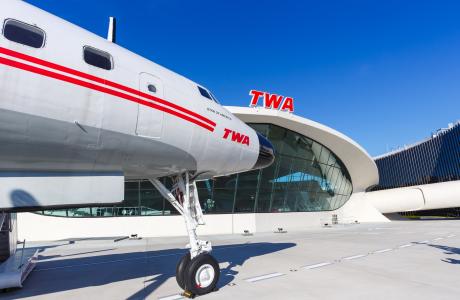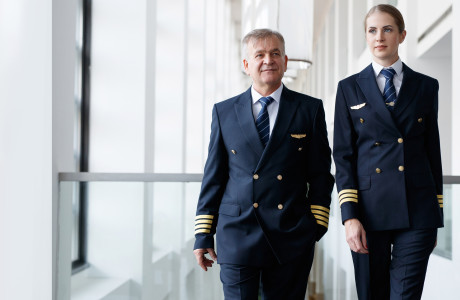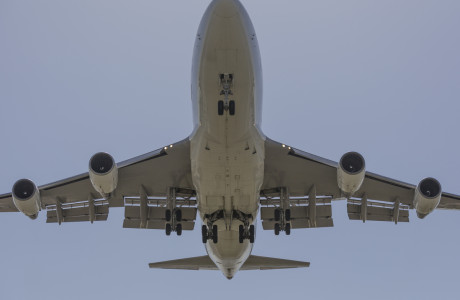
Howard Hughes: Producer, Pioneer, Pilot
Few lives could have been as spectacular as that of Howard Hughes. Superlatives and world records accompanied many of his ventures, from film productions and aviation to the acquisition of numerous hotels and casinos in Las Vegas. But his life was by no means without problems: Numerous crashes and accidents followed Howard Hughes' illnesses, which led to increasingly eccentric behavior and isolation. You can find an overview of Hughes' work and, above all, his contribution to aviation here.
Contents
Howard Hughes as an Aviation Pioneer: Hughes H1, H4 Hercules & TWA
The Later Years of Howard Hughes: Accidents, Illnesses & Isolation
The Life & Work of Howard Hughes: an Overview
Born in 1905 as the son and heir of a successful manufacturer of drilling machines, Howard Hughes quickly expanded into various industries after the early death of his parents, initially particularly in the film industry and aircraft manufacturing. This was followed by airlines, real estate, casinos and a medical institute. In the second half of his life, Howard Hughes became increasingly withdrawn after having previously been one of the most dazzling public figures. He died largely isolated from the outside world in 1976. The most remarkable facts about his life are summarized here in an overview:
World speed records: Hughes himself was an excellent but also reckless pilot. He set numerous world records, including the top speed record at the time in the Hughes H1 Racer, which he built himself.
Flying around the world: Hughes also excelled at long-haul flights. In 1938, he flew around the world in less than four days, beating the record at the time by more than three days. This achievement made him a true celebrity, so much so that a parade was held in his honor through Manhattan in New York.
The largest airplane in the world: Howard Hughes also built what was for a long time the largest airplane in the world, the Hughes H4 Hercules.
Stunt pilot: When Howard Hughes was shooting Hell's Angels, one of the most expensive films of all time to date, the stunt coordinator informed him that a certain flight maneuver was too dangerous. Hughes flew the maneuver for the film himself, but crashed - one of numerous accidents that may have contributed to his later health problems.
Transatlantic passenger flights: At his insistence, Howard Hughes' airline, TWA, was a driving force in the establishment of transatlantic flights with ground-bound passenger aircraft.
High society: In the 30s and 40s, Hughes was also known for his close relationships with the big stars of the time. Among others, Howard Hughes dated Ava Gardner, Katharine Hepburn, Bette Davies and Joan Crawford and was close friends with Cary Grant.
Image change for Las Vegas: In the 1960s, Howard Hughes acquired numerous hotels and casinos in Las Vegas and played a decisive role in developing the city's image in the glamorous direction for which it is known today.
Howard Hughes as an Aviation Pioneer: Hughes H1, H4 Hercules & TWA
Howard Hughes not only set individual records, but also drove innovation in both aircraft design and the operation of airlines and other aviation-related businesses. The following models and companies are particularly noteworthy:
Hughes H1 Racer: The racing airplane with which Howard Hughes set the first world records was completed in 1934 and was groundbreaking in many ways. The strong focus on aerodynamics, for example through a retractable undercarriage (a rarity at the time) and the use of countersunk rivets, subsequently became groundbreaking in aircraft construction. The model is said to have served as inspiration for numerous fighter planes during the Second World War.
Hughes H4 Hercules: This aircraft also set a record for Howard Hughes. The Spruce Goose, as it was also known, was the world's largest aircraft ever flown in terms of wingspan - a record the Spruce Goose held from its first and only flight in 1947 until 2019. The flying boat was built from wood to avoid using up vital resources during wartime and was intended to serve as a military transport. As construction was considerably delayed, the only aircraft was not completed until after the end of the war and the budget was significantly exceeded, Howard Hughes had to answer to a US Senate committee of inquiry. This was one of the reasons why he himself carried out its only test flight, to prove that he had not wasted any government money.
Hughes Aircraft: Howard Hughes' aircraft and prototypes such as the H4 Hercules were manufactured by his own design company. This company also manufactured weapons and armaments and later parts for the Galileo space probe. From the post-war period until the 1970s, the company had a virtual monopoly on armaments electronics vis-à-vis the US Department of Defense.
TWA: Howard Hughes took over TWA in 1937. The airline had been founded as Transcontinental & Western Air, but Hughes changed the name to Trans World Airlines when he began ambitious plans for long-haul flights around the globe after the end of the war. He retained control of the company until 1960 and engaged in fierce competition for flight routes and market share, particularly with Pan Am. This was also fought out politically - the investigation of the H4 Hercules by the Senate committee is also attributed to influence exerted by Pan Am. TWA remained successful even after Hughes and was one of the most important airlines, especially in the 1980s - in 1988 over 50% of passengers on transatlantic flights flew with TWA. However, the company was forced to declare bankruptcy in the early 1990s and the airline merged with American Airlines in the early 2000s.
The Later Years of Howard Hughes: Accidents, Illnesses & Isolation
Due to his risk-taking as a pilot, Howard Hughes also caused plane crashes, some of which had serious health consequences. For example, Hughes is said to have suffered from allodynia as a result of a particularly serious crash - an increased sensitivity to pain that could have caused him pain when cutting his hair and fingernails, but also when wearing clothes. This would at least partly explain his behavior in later years. From the late 1950s onwards, Hughes lived almost exclusively in hotel suites or even entire floors, shielded from the public. In his rooms, the same movies would often play on a continuous loop all day, while he himself would sit naked on his bed with his hair and nails uncut for months to years.
Obsessive-compulsive disorders are also said to have haunted him from his earliest years. It is known, for example, that Howard Hughes sometimes paid pedantic attention to the smallest details in his production company's films, which went far beyond any measure of artistic meticulousness. This obsessive behavior became increasingly prevalent in his later years and made his participation in public life more and more difficult. It has been verified, for example, that every object he wanted to touch had to be covered with paper towels by seven Mormons beforehand.
Hughes eventually died of kidney failure at the age of 70. His physical and mental limitations had clearly left their mark on him; in the end he was blind and weighed just 46 kg despite being 1.93 m tall.
The Complex Legacy of Howard Hughes
His later years made Howard Hughes a symbol of the rich eccentric for a long time. It can be assumed that some of his mental problems were not sufficiently known at the time to be diagnosed and that there were no appropriate treatment options. It is therefore impossible to say for sure how much of his behavior was actually illness or the result of his accidents. However, the great influence that Howard Hughes had on aviation remains undisputed. This mixture of success and fame with isolation and eccentric behavior have also made Hughes himself a popular subject for film biographies. The most famous of these is probably Martin Scorsese's The Aviator with Leonardo DiCaprio as Howard Hughes, while Katharine Hepburn was played by Cate Blanchett.
Even though TWA no longer exists and the prototypes developed by Howard Hughes are no longer in use, he still had a decisive influence on global air traffic. Perhaps you will soon find yourself on one of the old TWA routes - we wish you a good flight!



